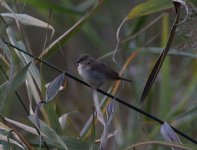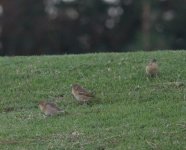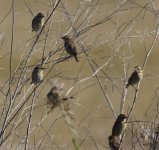opisska
rabid twitcher

I have invented the title after a long and fruitless day of searching for the cat. C birds in Portugal - later on, we did actually score 3 out of the 5 targets, but despite my wife’s best efforts in coming up with dozens of updated C-based puns, I still like this one the best, so you will have to deal with it. This whole thing is obviously inspired by Paul Chapman’s great article "Last chance to C" from the Big Year WP site, which seems to have gone dark recently though, so I can't link it here - if you ever find it, read it, it's fun!
We traveled for 10 days through Spain and Portugal, doing a 3000-km circuit from Madrid through Lisbon and Faro and back to Madrid, to a large extent focusing on mammals and herps, as the only reasonably expected new birds for us in the whole area are the cat. Cs, which I always shunned a bit as kinda plastic. Nevertheless, once we started looking for them, I got instantly hooked on the game and we spent several days doing so at the end, purely because it was a good adventure.
According to Lista de espécies - categoria C there are 10 pure cat. C birds in Portugal, out of which we already had 4 (and somewhat skipped thinking about a fifth one - Ruddy Duck), so we had five targets - Scaly-breasted Munia, Black-headed Weaver, Yellow-Crowned Bishop, Pin-tailed Whydah and Crested Myna; we got the first three and missed the last two. There also used to be Tricolored Munia, but I believe they are now extinct. Despite the common prejudice that those are “easy birds in a park”, none of the five targets seemed to be anywhere close to “easy”. We looked up sightings on eBird and looking at the map, they look quite numerous, but most of the birds are really nomadic and if you click at the hotspots you see that most places have just a few observations over many years.
We started north of Santarem, around the Paul do Boquilobo reserve, where the Whydah and Weaver looked promising, but neither in the reserve, nor at any other sites of recent eBird sightings around did we find anything. That notwithstanding, the Paul is really beautiful and we do not regret having spent the better part of the day there - and an evening visit of the Patudos dam in Apliarca did after all produce a single Scaly-breasted Munia in the reeds at the far end of the lake, moving in to overnight with a huge flock of Common Waxbills (which were generally one of the most common birds anywhere we went in Portugal, but not among the targets).
Giving up on this area meant giving up on the Whydahs, because they only occur there and more to the north, but we didn’t have infinite time, so we drove over to the Tejo delta. We saw the first Yellow-Crowned Bishop along the access road to EVOA in the agricultural land north of the estuary (which is gated, but the road to EVOA is open) and then a huge flock in reeds along the road to Barroca d’Alva. That area is well known for the Weavers, but neither there, nor in Paul do Rilvas a little bit to the south did we find any - according to my online friend who has seen one in Rilvas a few days before us, they have become really rare there.
And then came the Mynas, or rather did not come, but the day of searching for them was quite crazy. Encouraged by the absolute forest of sightings on the eBird map, we started trawling the southern cost of the estuary. We tried Riberia das Enguias, the abandoned northern part of Siderugia Nacional in Seixal, the municipal park in Seixal, Parque da Paz in Barrocas, a specific location of observations near the Caparica Sun Centre roundabout, Praia Trafaria, the Alpena hill, the municipal park in Caparica and Caparica beaches, but we found absolutely no Mynas, in one of the greatest dip of our lives. So we jumped into the car and drove all the way to Faro, where we found a flock of Black-headed Weavers at the grass of the San Lorenzo golf course, in the last light of the day, just before they disappeared in the reeds of the lake around 37.0318, -8.0110.
Overall, the landscape of central Portugal is quite nice. The ever-present Common Waxbills and the occasional Yellow-Crowned Bishop give the area a fine exotic touch. On the other hand, the searches for the Mynas and Whydahs in mostly urban settings wasn’t an experience I would be too keen to repeat any time soon. The most frustrating thing however is how difficult it is to move around Portugal - the country really needs to be educated in concepts such as “a bypass”, because even main roads are absurdly slow as they spend most of their lengths in narrow villages. You always look at the map, see a site 20 kms away as the Myna flies and then Google tells you it’s an hour away … Yes, they have highways, but not too dense of a network and moreover some of them can be paid for only through a complex maze of wireless boxes and prepaid cards that nobody who just spends a few days there is in the mood to sort out. On the other hand, the herping was quite stellar in some places, so they have that going on for them.
We traveled for 10 days through Spain and Portugal, doing a 3000-km circuit from Madrid through Lisbon and Faro and back to Madrid, to a large extent focusing on mammals and herps, as the only reasonably expected new birds for us in the whole area are the cat. Cs, which I always shunned a bit as kinda plastic. Nevertheless, once we started looking for them, I got instantly hooked on the game and we spent several days doing so at the end, purely because it was a good adventure.
According to Lista de espécies - categoria C there are 10 pure cat. C birds in Portugal, out of which we already had 4 (and somewhat skipped thinking about a fifth one - Ruddy Duck), so we had five targets - Scaly-breasted Munia, Black-headed Weaver, Yellow-Crowned Bishop, Pin-tailed Whydah and Crested Myna; we got the first three and missed the last two. There also used to be Tricolored Munia, but I believe they are now extinct. Despite the common prejudice that those are “easy birds in a park”, none of the five targets seemed to be anywhere close to “easy”. We looked up sightings on eBird and looking at the map, they look quite numerous, but most of the birds are really nomadic and if you click at the hotspots you see that most places have just a few observations over many years.
We started north of Santarem, around the Paul do Boquilobo reserve, where the Whydah and Weaver looked promising, but neither in the reserve, nor at any other sites of recent eBird sightings around did we find anything. That notwithstanding, the Paul is really beautiful and we do not regret having spent the better part of the day there - and an evening visit of the Patudos dam in Apliarca did after all produce a single Scaly-breasted Munia in the reeds at the far end of the lake, moving in to overnight with a huge flock of Common Waxbills (which were generally one of the most common birds anywhere we went in Portugal, but not among the targets).
Giving up on this area meant giving up on the Whydahs, because they only occur there and more to the north, but we didn’t have infinite time, so we drove over to the Tejo delta. We saw the first Yellow-Crowned Bishop along the access road to EVOA in the agricultural land north of the estuary (which is gated, but the road to EVOA is open) and then a huge flock in reeds along the road to Barroca d’Alva. That area is well known for the Weavers, but neither there, nor in Paul do Rilvas a little bit to the south did we find any - according to my online friend who has seen one in Rilvas a few days before us, they have become really rare there.
And then came the Mynas, or rather did not come, but the day of searching for them was quite crazy. Encouraged by the absolute forest of sightings on the eBird map, we started trawling the southern cost of the estuary. We tried Riberia das Enguias, the abandoned northern part of Siderugia Nacional in Seixal, the municipal park in Seixal, Parque da Paz in Barrocas, a specific location of observations near the Caparica Sun Centre roundabout, Praia Trafaria, the Alpena hill, the municipal park in Caparica and Caparica beaches, but we found absolutely no Mynas, in one of the greatest dip of our lives. So we jumped into the car and drove all the way to Faro, where we found a flock of Black-headed Weavers at the grass of the San Lorenzo golf course, in the last light of the day, just before they disappeared in the reeds of the lake around 37.0318, -8.0110.
Overall, the landscape of central Portugal is quite nice. The ever-present Common Waxbills and the occasional Yellow-Crowned Bishop give the area a fine exotic touch. On the other hand, the searches for the Mynas and Whydahs in mostly urban settings wasn’t an experience I would be too keen to repeat any time soon. The most frustrating thing however is how difficult it is to move around Portugal - the country really needs to be educated in concepts such as “a bypass”, because even main roads are absurdly slow as they spend most of their lengths in narrow villages. You always look at the map, see a site 20 kms away as the Myna flies and then Google tells you it’s an hour away … Yes, they have highways, but not too dense of a network and moreover some of them can be paid for only through a complex maze of wireless boxes and prepaid cards that nobody who just spends a few days there is in the mood to sort out. On the other hand, the herping was quite stellar in some places, so they have that going on for them.










